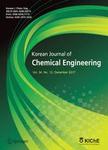版权所有:内蒙古大学图书馆 技术提供:维普资讯• 智图
内蒙古自治区呼和浩特市赛罕区大学西街235号 邮编: 010021

作者机构:Kasetsart Univ Dept Chem Engn Bangkok 10900 Thailand King Mongkuts Univ Technol Thonburi Dept Chem Engn Bangkok 10140 Thailand Natl Ctr Excellence Petr Petrochem & Adv Mat Bangkok 10330 Thailand
出 版 物:《KOREAN JOURNAL OF CHEMICAL ENGINEERING》 (韩国化工杂志)
年 卷 期:2011年第28卷第2期
页 面:332-341页
核心收录:
学科分类:081704[工学-应用化学] 0817[工学-化学工程与技术] 08[工学] 0703[理学-化学]
基 金:National Center of Excellence for Petroleum, Petrochemicals and Advanced Materials Graduated School, Kasetsart University
主 题:Wastewater Minimization Genetic Algorithm Mixed Integer Nonlinear Programming
摘 要:The optimum water usage network leads to both a minimum of freshwater consumption and a minimum of generated wastewater. This work is to develop a mass-exchange networks (MENs) module for a minimum freshwater usage target. This module works as an interface to retrieve supplemental data of chemical processes from a process simulator and to communicate this to the genetic algorithm optimizer. A reuse system and a regeneration/recyclingsystem with a single contaminant are considered as approaches for freshwater minimization. In the formulated model, as mixed integer nonlinear programming (MINLP), all of the variables are divided into independent and dependent variables. The values of independent variables come from randomization,whereas the values of dependent variables come from simultaneous solutions of a set of equality constraints after assigning the values of independent variables. This method is applied to the steps of initialization, crossover and mutation. The MENs module is validated with a tricresylphosphate process consisting of five unit operations. Water is used to remove a fixed content of cresol. From the result, the module gives a reliable solution for freshwater minimization, which can satisfy mass balance and constraints. The results show that reuse and regeneration/recycling strategies can reduce freshwater consumption, including wastewater generated. Reuse cannot decrease the mass load of the contaminant, while regeneration/recycling can. In addition, regeneration requires less freshwater than the reuse process.